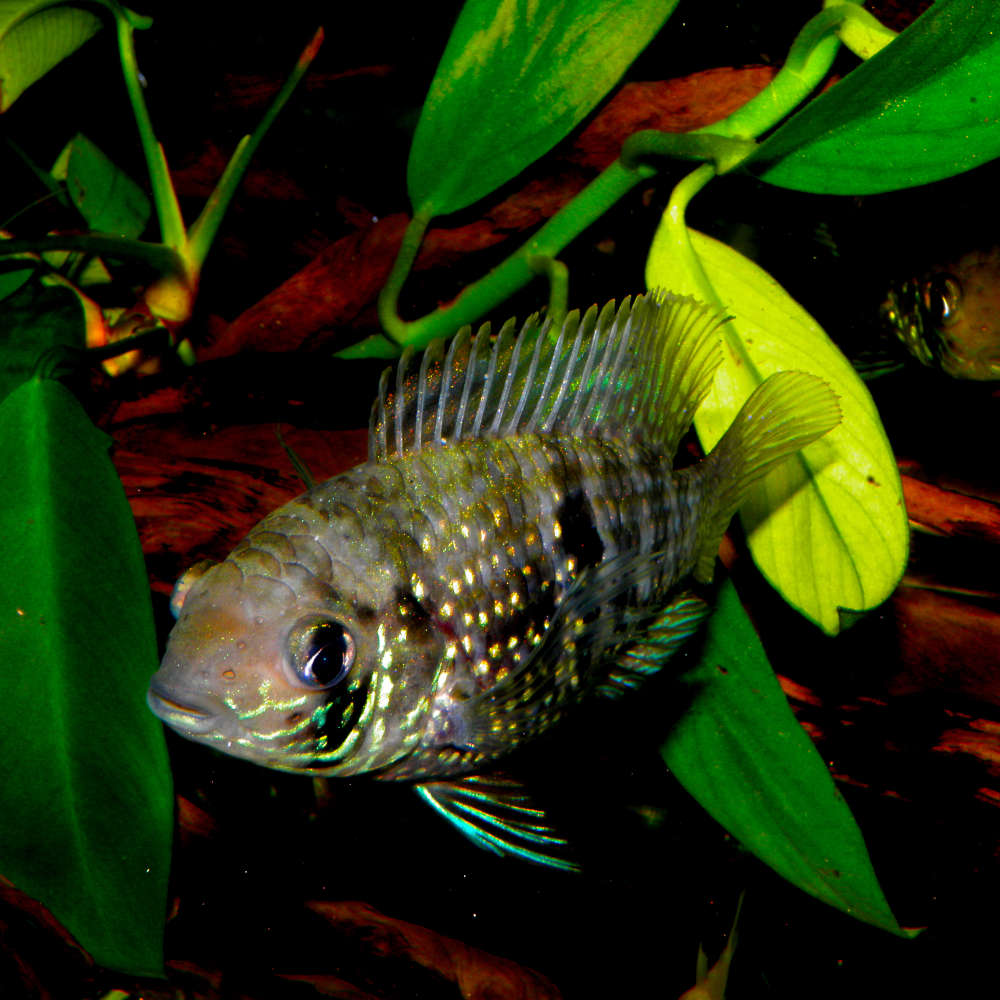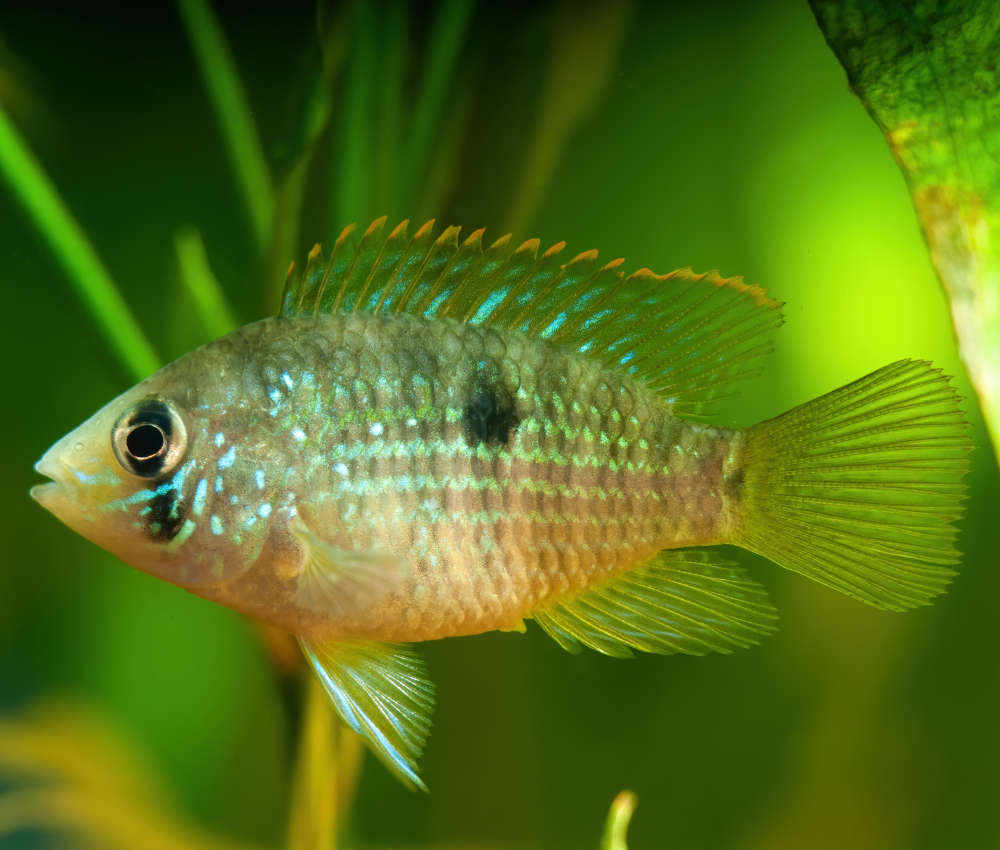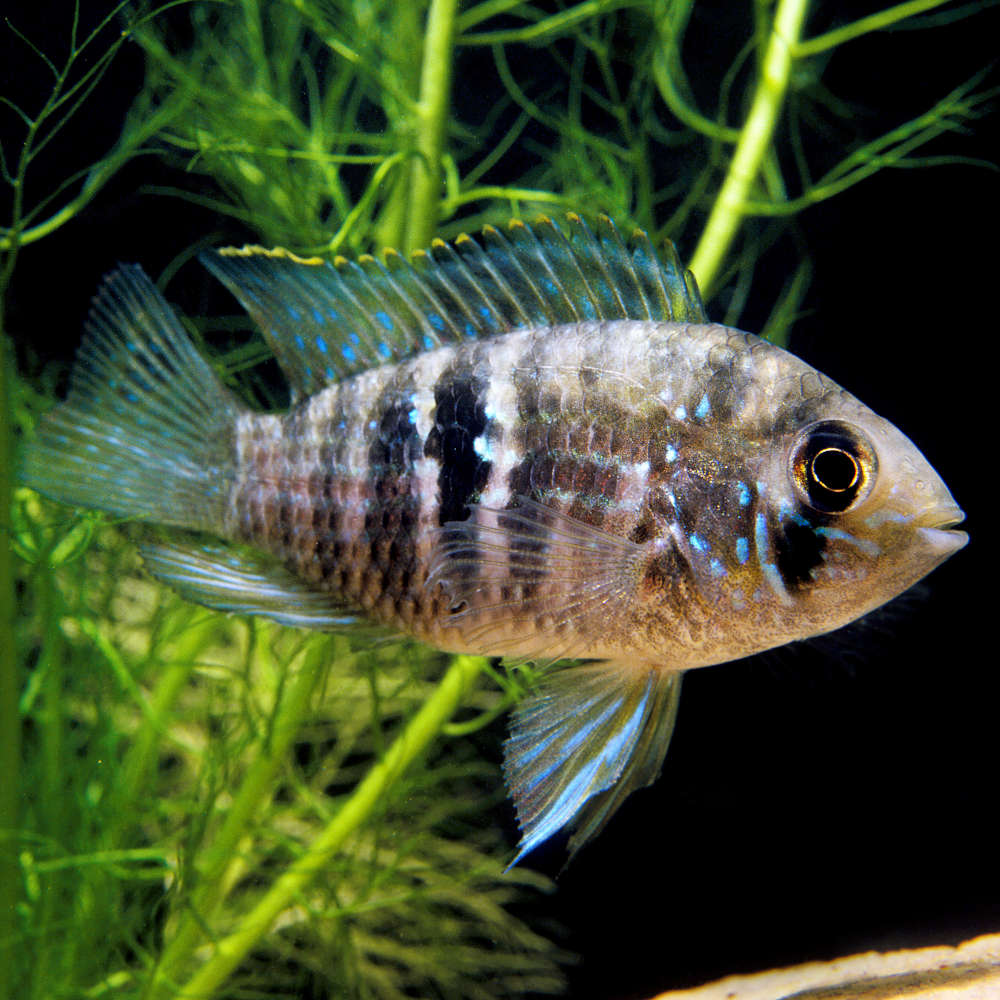If you’re a novice aquarist and want to get a cichlid, the blue acara won’t let you down. The fish has been quite a popular choice for peaceful, well-researched community tanks.
This medium-sized darling accepts almost all kinds of food, which is another reason why it is a cult-favorite.
Now, if you’re interested in getting it, let’s learn to care for it!
What is Blue Acara Cichlid?
Blue Acara cichlid is a freshwater fish which belongs to the Cichlidae fish family and is perfect for the aquariums. Below are some more features of a blue Acara cichlid:
| Origin | Trinidad, Venezuela, Central and South America |
| Order | Cichliformes |
| Family | Cichlidae |
| Scientific Name | Andinoacara pulcher |
| Common Names | Blue coscarob, Green coscarob, Pulcher |
| IUCN Red List Status | Least Concern |
| Appearance | Ovaloid, steel blue-gray body, several spots, and stripes |
| Size (Adult) | Around 13-16 cm (5.12-6.3 in) |
| Lifespan | About 7-10 years |
| Temperament | Semi-aggressive |
| Tank Level | Bottom dwellers |
| Water Temperature | 72-86 °F (22-30 °C) |
| pH Level | 6.5-8 |
| Water Hardness | Up to 20 dGH |
| Care Level | Easy |
| Minimum Tank Size | 30 gallons for 1 fish |
| Tank Environment | Sandy substrate, moderate flow, planted tank |
| Diet | Carnivorous |
| Tank Mates | Own mate, similar-sized and similar-tempered species |
What is the Natural Habitat of Blue Acara Cichlid?
Electric blue acara is native to parts of Venezuela, Colombia, Trinidad, and Tobago of Central and South America. It has also been introduced to other nations.
The adaptable fish can be spotted in both muddy, still water and flowing clearwater rivers and streams. It prefers to swim around densely vegetated waters with rocky formations and submerged tree roots.
The fish was labeled Least Concern according to the 2020 assessment of The IUCN Red List of Threatened Species.
Which family does Blue Acara Cichlid belong?
The cichlid belongs to the Cichliformes order and the Cichlidae family. Its binomial name is Andinoacara pulcher, while it’s known by various common names like blue acara, blue coscarob, green coscarob, and pulcher.
Fun Fact: This fish is often confused with a larger and similar-looking fish – green terror.
How do Blue Acara Cichlid look?
If you’re curious about the looks and temperament of the cichlid, let’s know about it all here…
What is the Size of Blue Acara Cichlid?
Blue acara reaches up to 13-16 cm (5.12-6.3 in) in captivity. The fish may grow bigger in the wild.
What is the Color of Blue Acara Cichlid?
This fish has a steel blue and grey color with several spots and stripes on its head and body and red or orange-tipped fins. You may also spot some green horizontal stripes on its face.
It has bluish-green scales, which makes it look sparkly. The lower areas of its face and belly have a golden sheen. A distinct black line runs across its eyes to its cheeks.
Its body may have brown, blue, or black hues, which vary depending on the locality. There are also 5-8 black vertical stripes. These may not be noticeable in all specimens.
What does an Electric Blue Acara Color Morph look like?

There’s a variety of this cichlid – electric blue acara. It’s either a selectively bred variety of the cichlid or a hybrid from blue ram eggs fertilized by blue acara sperm. This has more intense solid blue shades and lacks golden shades.
The names blue acara and electric blue acara (EBA) are used interchangeably. Some shops might even sell EBA under the name of blue acara. Both varieties have the same care needs, so you can refer to this care guide for both.
What are the Features of Blue Acara Cichlid?
Blue acara has an oval-shaped, laterally compressed, compact, stocky body and pointy dorsal and anal fins.
Like all cichlids, it has pharyngeal teeth in its throat other than teeth on the jaw. There are spiny rays in the rear parts of its dorsal, anal, pelvic, and pectoral fins.
It also has one nostril on either side. The cichlid can sense the “smell” of other species by sucking in water.
What is the difference between a male and female Blue Acara Cichlid?
Both genders look pretty similar, with minute differences. The fins of male fish are longer than the female. His dorsal and anal fin rays arches around his tail fin. The female fish shows less bright colors and is more rounded than the male.
The fish’s color intensifies during spawning or when excited.
What is the behavior of Blue Acara Cichlid?
Blue acara is semi-aggressive – peaceful and docile for a cichlid this size. However, the diurnal fish may act aggressively or prey on smaller species.
The bottom dweller also forms small schools. It’s monogamous, aggressive, and territorial when mating.
How long do Blue Acara Cichlid live?
In captivity, the blue acara can live up to anywhere from 7-10 years. With optimum care, your pet may also live longer.
In the wild, some say the fish lives much longer – up to twice as long.
Author’s Note: This cichlid was initially a member of the Aequidens genus. It was switched to the Andinoacara genus in 2009.
How to take care of Blue Acara Cichlid?

Now that you know all about this fish’s appearance, let’s dive deep into the care guidelines.
What is the Tank Size for Blue Acara Cichlid?
You can keep one acara in a 30-gallon tank. If you want more, an additional 15 gallons for each extra fish is required. So, if you want a small group, a 75-gallon tank is ideal for 4.
If you want to keep a pair, you’ll need a (30+15) 45-gallon tank. However, the standard tank sizes are 40 and 55 gallons.
Many take the 40-gallon one because 40 is closer to 45 than 55. However, in my experience, the fish needs plenty of space. So, always chose to opt for a 55-gallon tank instead!
What is the Water Chemistry for Blue Acara Cichlid?
The blue acara is sensitive to water chemistry. So, to keep your pet fish healthy and kicking for the longest time, maintain these parameters.
- pH Levels: 6.5-8
- Water Temperature: 72-86 °F (22-30 °C)
- Water Hardness: Up to 20 dGH
- Ammonia: 0 ppm
- Nitrite: 0 ppm
- Nitrate: Less than 20 ppm
What should be the Tank Environment for Blue Acara Cichlid?
You must also make the fish feel at home by recreating its natural habitat.
Should Substrate be kept in the tank for Blue Acara Cichlid?
This cichlid often picks and sifts the substrate in search of food. So, use a soft, fine, sandy substrate to ensure your pet doesn’t get hurt.
Which Plants are needed for Blue Acara Cichlid tank?
The cichlid’s native waters have lots of plants as shelter. However, it’s known to dig plants, so use sturdy potted and deep-rooted plants like:
- Java ferns
- Amazon swords
- Vallisneria
- Sagittaria
- Anubias
- Hornwort
- Water sprite
- Waterweed
But make sure there’s plenty of free swimming space.
What type of Lighting is needed for Blue Acara Cichlid?
Blue acara is comfortable with normal to moderate lighting and limited sunlight. This helps the fish show its best colors.
What type of Décor is needed for Blue Acara Cichlid?
As decor, you can use rocks, caves, and driftwood. Add some dried beech and Indian almond leaves to mimic its native waters. Decomposing leaf litter also brings natural microbe colonies which are a food source for the fish and fry.
Which filters are needed for Blue Acara Cichlid?
Since the fish is pretty sensitive to water parameters, use a sturdy and efficient filtration system like a canister, hang-on-back, or powerhead filter. Perform weekly 30% water changes as well.
What should be the Water Flow Rate of the aquarium with Blue Acara Cichlid?
In the wild, the fish withstands a range of water flow. However, in captivity, it’s best to maintain a gentle to moderate flow. Some suggest strong water flow, but that works only if you have low-flow regions for the fish to rest.
Do Blue Acara Cichlid jump out of the tank?
Blue Acara Cichlid species is known for its frequent jumps. So, ensure your tank has a tight-fitting lid.
What do Blue Acara Cichlid eat?
The blue acara is omnivorous but loves carnivorous treats. In the wild, it thrives on a diverse diet. In captivity, you can feed a combination of live, frozen, and dried feed with commercial feed and vegetables. Here are a variety of food for it:
- Brine shrimp
- Bloodworm
- Tubifex worm
- White worm
- Red earthworm (serve live for best coloration of fish)
- Daphnia
- Small insect
- Chopped prawn or mussel
- Blanched spinach
- Spirulina-based food
- Cichlid tablets, flakes, and pellets
The cichlid needs high-protein meals, so at least half the meal must be carnivorous. Feed it twice a day – in the morning and night. The entire meal quantity throughout the day must be 2-5 pinches.
Avoid feeding one large meal a day. Fast the fish one day every week.
What are the Tank Mates for Blue Acara Cichlid?

The blue acara’s best tank mate is its own kind. So, try to keep at least two of the opposite gender. Besides that, you can keep other peaceful cichlids, cories, and a few similar-sized, peaceful species like the following:
- Discus cichlid
- Pearl cichlid
- Freshwater angelfish
- Uaru cichlid
- Firemouth cichlid
- Convict cichlid
- Jaguar cichlid
- Jack Dempsey cichlid
- Plecostomus
- Leopard pleco
- Bristlenose pleco
- Cory catfish
- Rosaline shark
- Silver dollar
- Rainbowfish
- Medium-sized gourami
- Giant danio
Some suggest medium-sized tetras as tank mates. However, they may try to nip the cichlid’s fins or even get harassed by the cichlid.
Which Tank Mates to Avoid for Blue Acara Cichlid?
Avoid keeping your blue acara with the following types of species:
- Fin-nippers: They might attack your acara’s fins.
- Aggressive species: They’ll terrorize your pet.
- Smaller fish/invertebrates: They’ll get eaten or chased by the acara.
Namely, some non-compatible tank mates are:
- Flowerhorn cichlid
- Wolf cichlid
- Tetra (neon, redeye, black skirt, serpae, and lemon tetra)
- Betta
- Red tail shark
- Regular sized danio
- Dwarf shrimp
- Cherry shrimp
- Snail
What are the Common Diseases associated with Blue Acara Cichlid?
Blue acara isn’t prone to any specific disease. However, it gets affected by the most common ailments like the following:
| Disease Name | Causes | Symptoms | Treatment |
|---|---|---|---|
| Ich | External protozoan parasite | White spot, flashing, lethargy, appetite loss | Add ich medicines, increase water temperature |
| Skin fluke | Parasitic infection | Red spots, excess mucus, heavy breathing, flashing, missing scales, lethargy, appetite loss | Control water quality and diet, give medications |
| Fin rot | Bacterial infection | Frayed, disintegrated, or discolored fins, lethargy, appetite loss | Improve water chemistry, remove objects with injury risks, give antibiotics |
| Columnaris | Bacterial infection | Gray/white patches, frayed fins, lethargy, appetite loss | Improve water chemistry, give antibiotics, reduce stress |
Quick Tip: Keep your cichlid on a healthy diet and maintain water quality. It will prevent most diseases in your pet.
How to Breed Blue Acara Cichlid?
Blue acaras are one of the easiest cichlids to breed, but it’s difficult to differentiate them sexually. However, you can overcome this and successfully breed them with the following steps:
Pair Choosing & Conditioning
Buy 6 young fish and raise them in a 125-gallon tank. The monogamous fish will naturally pair up if there are males and females in the group.
These fish start breeding when they are 10 cm (4 in) long. So, pick a pair of at least that size and condition them with live and frozen feed.
Breeding Tank Preparation
In a 75-gallon breeding tank, set up an air-powered filtration system and flat stones, thick sandy substrate, and broad-leaved plants as spawning sites. Fill in water and maintain the following numbers:
- Water Temperature: 77-82 °F (25-28 °C)
- pH Levels: 6.5-7
- Water Hardness: 6-20 dGH
Once the tank is ready, introduce the pair in it.
Mating
For a while, the male courts the female by flaunting his bright colors.
The substrate spawning pair chooses and thoroughly cleans their spawning site. When the female is ready, she lays up to 200 eggs and moves away. The male fish then externally fertilizes them.
What is the Incubation period for Blue Acara Cichlid eggs?
The eggs hatch within 48-72 hours. Meanwhile, the male fish defends the spawning territory and the female cares for the eggs. They switch places in between.
After the eggs hatch, the fry lives on their egg yolk for 72 hours. Then, they become free swimmers and can be fed baby brine shrimp, nematodes, rotifers, and microworms.
They receive parental care for up to 2 weeks. Beyond that, the pair may mate again.
When fed appropriately, the fry grows up to an inch within a few months.
Breeding Tip: The cichlids may eat their first brood, but don’t be discouraged. Give them another try, and they’ll learn to care for their eggs.
What to keep in mind while buying Blue Acara Cichlid?
While buying blue acara, check for signs of good health, like
- Vibrant body color
- Clear eyes
- No damage on the body or fins
You must also check its tank. Don’t buy the fish if the tank is overcrowded or poorly maintained. Those specimens may fall sick sooner or later.
A word from FishInAquarium
Blue acara is not only a glamorous-looking fish but also a treat for the eyes. The curious and active species is also fun to breed.
If you’re content with this article and found the answers to all your questions, share it with other enthusiasts. Adopt this cichlid together and share the joy with everyone!
If there are more questions, reach out via email, and we’ll get back to you!


